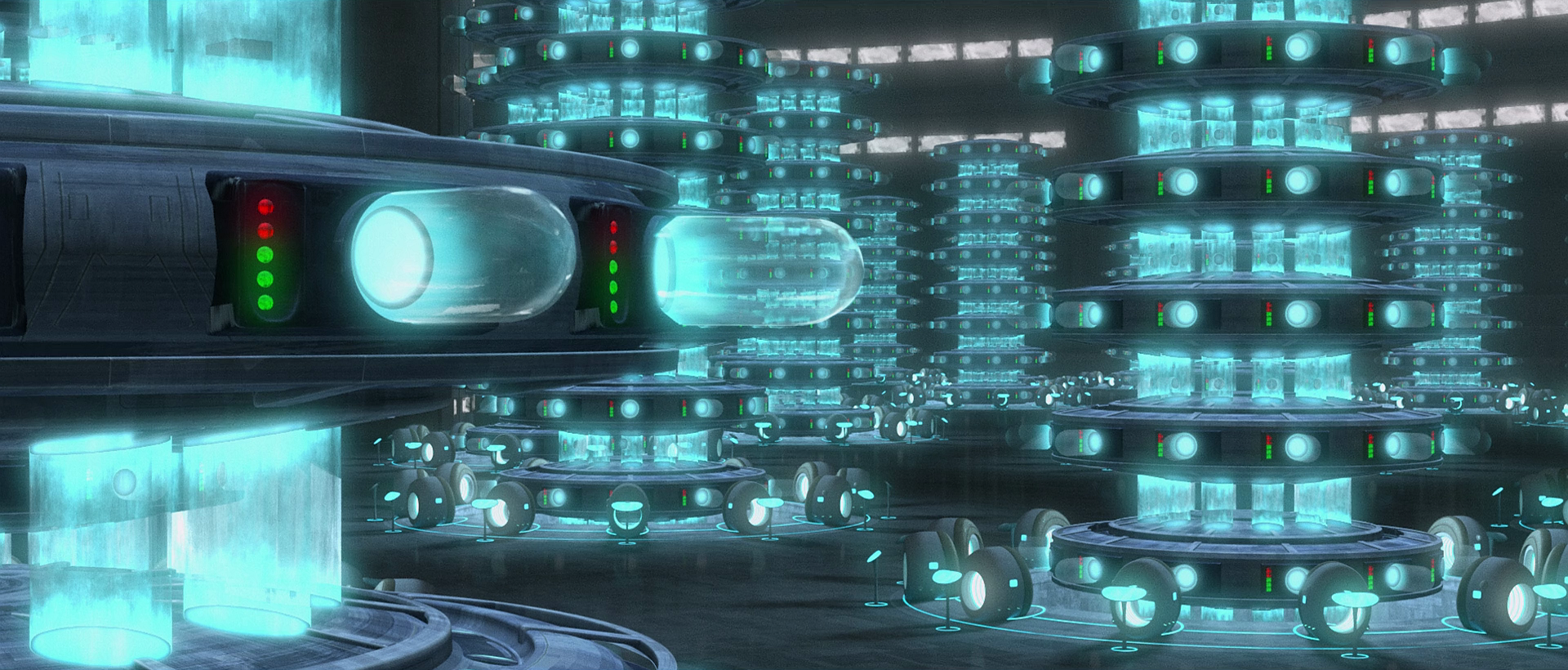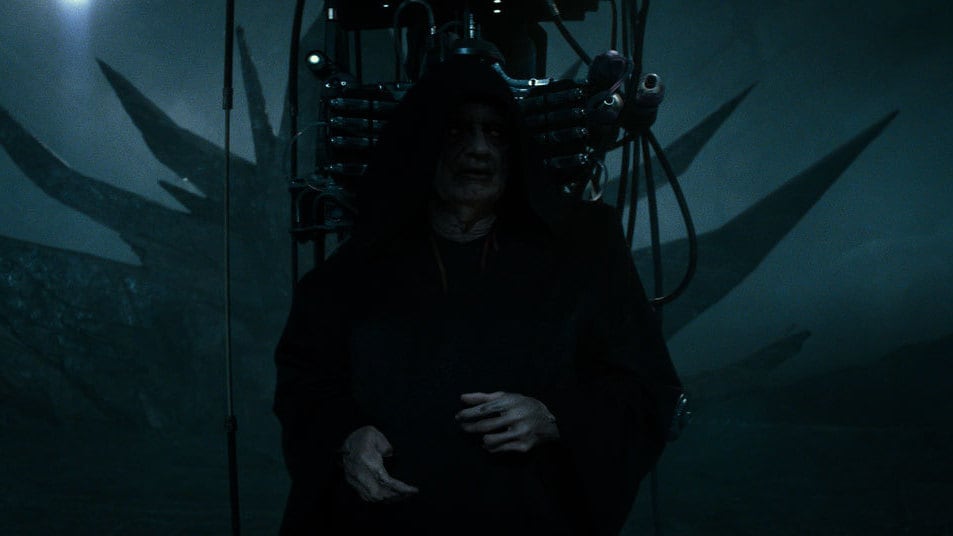The Imperial cloning program referred to a vast array of projects undertaken by the Galactic Empire and its affiliated organizations to further study, reproduce, and improve upon Kaminoan cloning and genetic engineering technology utilized during the Clone Wars. As part of Emperor Palpatine's Contingency, the Imperial cloning program sought to create a Force-sensitive strandcast capable of serving as a replacement body for Palpatine, thus allowing him to achieve immortality.
Despite the formal surrender of the Galactic Empire in 5 ABY, the Imperial cloning program continued its mission for decades afterwards. Cloning experts within the Sith Eternal cult were capable of preserving Palpatine's spirit within a decaying clone body on Exegol, thus preventing his complete death for several decades. Palpatine was ultimately killed in 35 ABY at the hands of his granddaughter, Rey, who was naturally born from a failed strandcast of Palpatine who escaped his containment.

The Galactic Empire confiscated the cloning technology of Kamino, where the clone troopers were made.
With the proclamation of the New Order and the near-annihilation of the Jedi Order, Galactic Emperor Sheev Palpatine—the Sith Lord Darth Sidious—ruled over the largest governing body in the galaxy. The clone troopers of Kamino were phased out in favor of natural-born human conscripts owing to their cheaper cost as stipulated by Project War-Mantle. The Kaminoan government's contracts to produce the clones with the former Galactic Republic were declared null and void, and a new generation of TK troopers assisted with removing all essential personnel from the hatcheries at Tipoca City. Chief Medical Scientist Nala Se and her research were secured along with other Kaminoan cloning personnel for later use by the Galactic Empire. Prime Minister Lama Su had grown certain that the Empire would eventually destroy the Kaminoans' ability to create clones; after Tipoca City was decommissioned, Vice Admiral Rampart had it destroyed by a group of Venator-class Star Destroyers.
With their cloning technology firmly under the control of the Empire alone, any other Kaminoan facility on the planet was also destroyed. Meanwhile, the Empire had moved its experiments to a facility based at Mount Tantiss on the forested planet of Wayland. Under escort of clone commandos, Nala Se was brought to the planet to work for the Empire, with an Imperial scientist named Scalder claiming they were inspired by her work.
During the Imperial Era, Imperial scientists sought to replicate the cloning capabilities of the Kaminoans. As Emperor Palpatine sought to achieve immortality, much research was done to accomplish this goal.
Continuing the work of the IMDAWR, the Advanced Science Division led by doctor Royce Hemlock of the former Republic Science Corps undertook the massive project of cataloguing and repurposing Kaminoan technology to analyze the finest details of their cloning process and replicate it in their own projects. To that end, all of the Kaminoans' surviving tech was transferred to the Tantiss Base on Mount Tantiss, where Imperial scientists began modifying and testing it. Eventually, the technology from Nala Se's private lab, which was originally used to create Clone Force 99 was recovered intact and transferred to the facility. Imperial engineers successfully utilized Se's top secret developments to finalize the work started by Sionver Boll during the Clone Wars and develop live Zillo Beast clones, despite the last specimen being long dead. The resulting Beasts lived a normal life cycle, developing from their infant state to a fully grown adult within mere days.
Following this initial success, the Advanced Science Division began kidnapping clone troopers, who had been decommissioned following the implementation of the Imperial Defense Recruitment Bill and experimenting on them in Tantiss' underground laboratories. These clones were kept in a state of suspended animation, oftentimes within vats.
Under the supervision of the Imperial Military Department of Advanced Weapons Research and its Sith scientists, Project Blackwing managed to revive necrotic tissue, transforming dead Imperial stormtroopers into animated corpses, before a containment breach resulted in Undead Troopers' escape. Another project undertaken by the Tarkin Initiative created Hutt clone troopers, which were ultimately rejected for wide-scale use.

Darth Sidious utilized Exegol as the secret location of his genetic experiments during his reign as the Emperor.
On the hidden Sith world of Exegol, with the aid of the Sith loyalists of the Sith Eternal cult, a laboratory—among a retrofitted, automated ancient shipyard forges in the Forbidden District—was erected for biomedical and genetic engineering research in the hopes of creating a successful strandcast body for Sidious. This research was partly based upon former Kaminoan cloning technology. Additional research was undertaken, resulting in the creation of multiple genetic constructs, an elite Exegol Sith guard called the Tankers, and other frail oddities kept within vats and in a constant state of pain.

The Emperor resurrected himself by transferring his spirit to a clone of his original body.
The fall of the "Old Empire" did not see the end of the Imperial cloning program. Sidious' essence managed to be transferred to a clone body on Exegol. However, the research was not yet completed and the body was too weak to hold Palpatine's Force power, rendering him weakened and attached to an Ommin harness. Brendol Hux, a member of the Imperial Remnant's Project Necromancer and Shadow Council, was very interested in cloning, with Moff Gideon declaring it an obsession of his.
Without the approval of the rest of the Shadow Council, Gideon's Imperial remnant performed genetic experiments as late as 9 ABY under the direction of clone engineer Doctor Penn Pershing. That Imperial remnant put a bounty on the head of Grogu, a Force-sensitive child with a high concentration of midi-chlorians in his blood, which was essential in experiments attempting to achieve Force-sensitivity in cloned bodies of Gideon himself. An Imperial base on Nevarro kept standcast bodies in vats of liquid and was overseen by scientists with similar Kaminoan symbols on the right shoulder of their scientist uniforms. That base was destroyed by Din Djarin, Cara Dune, Greef Karga, and the Mythrol.
After Gideon was captured by Djarin during the second rescue of Grogu, Gideon was extracted from New Republic custody by Imperial armored commandos. Gideon moved his cloning experiments to the planet Mandalore, where he hid his operations within a hidden undergound base. Gideon successfully created a group of clones of himself and believed they would be able to use the Force. However, they were destroyed by Djarin and Grogu during the reconquest of Mandalore, with Gideon himself soon meeting his end in the battle.

The Emperor's cloned DNA was used in the creation of a failed strandcast, who, in turn, sired a daughter named Rey.
On Exegol, numerous failed strandcasts were created and discarded, including a partially-successful Snoke, which Sidious used to rule the First Order while he hid in the shadows. Another failed strandcast was Rey's father, a perfectly normal human without any Force sensitivity, who Sidious allowed to leave and propagate his family line through more natural means. He was considered his "son." This strandcast ultimately fathered Rey with a human female. Afraid of Sidious capturing their daughter who was an extremely powerful Force user, Rey's parents hid her on Jakku before they were ultimately killed.
During the Battle of Exegol in 35 ABY, Sidious was killed by his granddaughter Rey, ultimately defeating the Dark Lord of the Sith and his followers. In repudiation of her bloodline, Rey adopted the family name Skywalker.
- Star Wars: The Rise of Skywalker: The Visual Dictionary
- The Star Wars Book
- Skywalker: A Family at War